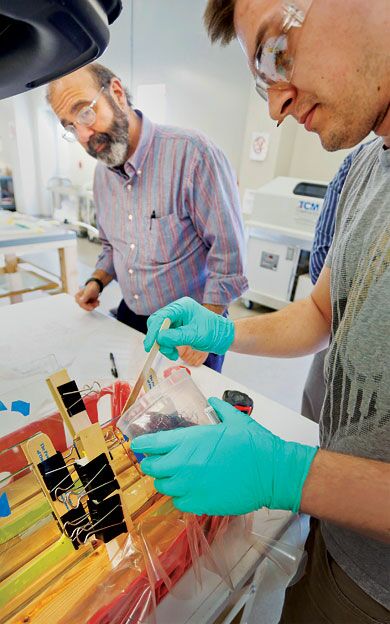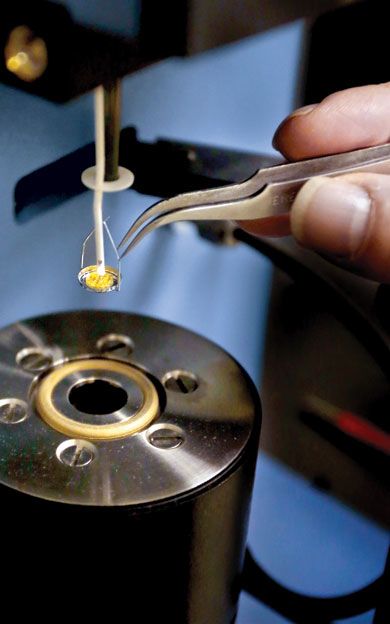SMCC composites lab benefits manufacturers
Andy Schoenberg, director of the new composites lab at Brunswick Landing, recalls the day a visiting Amtrak representative casually mentioned a problem that literally has been a pain in the back for its conductors: They have to lug and position heavy metal boarding ramps at rail depots.
“Can you help?” Schoenberg says the Amtrak rep asked. “I said, 'I think we can. I'd like a conductor to come in with a ramp and we'll see what we can do.'”
When Southern Maine Community College's Schoenberg says 'we' he really means it. When an Amtrak conductor came in with the 28-pound steel ramp, it became the centerpiece of a hands-on lesson for his students. The students learned how to define the problem, run a computer program to sketch a design and began an initial evaluation of how composites might be used to create a lighter, but equally strong, ramp.
Then Schoenberg took it one step further. He invited Kenway Corp., an Augusta company with more than 40 years of experience manufacturing corrosion-resistant fiberglass products, to take a look at his students' work. He had a strong feeling Kenway would be interested.
He was right. Kenway CEO Ken Priest says the company has used the students' research to build two prototype composites ramps for Amtrak, with the latest version being less than half the weight of the original steel ramp. He's hopeful that Kenway is now on Amtrak's radar as a potential supplier should the rail line decide to invest in lightweight passenger ramps.
“To me, it's an absolutely perfect partnership,” Priest says of the collaboration between his company and the students in the SMCC composites program. “Andy knows what we need in industry in order to succeed. He's lived it. And for his students, he's taking real-life problems that we have in industry and is challenging them to solve them.”
The partnership got its start two years ago, when the Maine Composites Alliance and SMCC decided to tackle recurring work force training issues head-on with a new composites technology degree program. Schoenberg brings almost 32 years of materials manufacturing experience within various composites industries, including 10 years at Fairchild Semiconductor in South Portland. The program includes the Composites Engineering Research Laboratory, which is equipped with more than a dozen precision analytic instruments that provide training for students and research for companies involved in composites testing.
Funded by a three-year Maine Technology Institute grant, and owned and managed by MCA and its industry partners, the $1.25 million lab has already been tapped by Maine composite companies that are developing new products or seeking to expand their reach into existing markets. Companies pay a sliding-scale fee based on the nature and complexity of their project. The intent is for those revenues to help make the lab a self-sustaining operation.
“We've done more through CERL [to directly impact] the composites industry in Maine than any other project I've been involved in,” says Steve Von Vogt, CEO of Maine Marine Composites in Portland and managing director of the MCA. “A lot of the work being done there is for companies that want to grow. The lab is really in its infancy — we've only been doing this for roughly a year and a half — but because of the MTI grant, there's access to Andy and his incredible expertise. You can call him up and pick his brain.”
The four-semester program, which can take 20 to 25 new students per year, is expected to produce technicians, all of whom, says Von Vogt, “are hired before they even get out with their degree.”
Training people for careers in composites is essential to those manufacturers that are predicating growth on composite materials. While the largest segments in Maine's composite industry are boatbuilding and marine infrastructure materials, Von Vogt says aerospace, wind and ocean energy, construction and transportation are expected to be the dominant markets driving its growth. Capturing those markets, he says, hinges on the availability of workers who not only know composite materials and their capabilities, but are also comfortable with the design-build-test approach used by successful entrepreneurial manufacturers.
“For us to accelerate our growth and have a competitive advantage, we have to raise our science and technology and our manufacturing capabilities,” he says. “We have to be able to compete at a level we haven't competed at before.”
Real-life problems
Hired in July 2011 to create SMCC's composites technology degree program, Schoenberg says his curriculum is guided by his broad engineering background, including his work at Fairchild Semiconductor, where he was responsible for materials processing and testing, failure analysis and engineering problem-solving.
“What I've tried to do is take an absolute industry approach to this program,” he says. “I don't like to do things that have no value in the real world. We try to set up projects that will solve real-world problems for companies. We're already getting a very good name for ourselves for solving practical problems, through both our classes and CERL.”
Schoenberg says the program starts with a “looking down from 10,000 feet” overview that gives students a broad-based understanding of the diverse ways composites are used by five key industries: marine, alternative energy, avionics/aerospace, construction and consumer products. The next three semesters drill down into the characteristics of different composite materials and their applications, manufacturing and repair processes, fundamentals of quality and testing, advanced processes, lean manufacturing, with an internship at a composites company as the final course.
Without question, he says, having a sophisticated research lab adjacent to his classroom is a unique asset that gives his students opportunities to solve real-world problems as an integral part of the associate degree program's curriculum.
For instance, Kenway tapped the lab to test the viscosity of a particular resin at various temperatures.
“That was invaluable to us,” Priest says. “That saved us a lot of money. He's helping us analyze various problems. His lab is able to go much further into the chemistry [of the process] than we can in Augusta. That has allowed us to be more competitive, because we now know more about the chemistry of resin than our competition.”
That's exactly the kind of feedback Schoenberg wants to hear, and he's passionate about the lab's capabilities and its value to both his students and Maine companies competing in an increasingly global composites marketplace.
“This is either the sixth or seventh laboratory I've set up,” Schoenberg says. “This lab is the culmination of my knowledge and experience working with polymer materials and doing composites characterization and modeling in a broad array of industries in the Northeast. Each piece of equipment in this lab characterizes a different behavior. If you don't have that capability — if you don't have all of those tools in your toolbox — all you can do is conjecture. The tools we have take it out of the realm of trial and error and it becomes science.”
Access to those tools, he quickly adds, is commensurate to a student's level of training and strict adherence to operating procedures.
“I've based my program and what I'm doing here on the electronics industry and its emphasis on total quality control,” he says. “When you make 10 billion electronic devices a year [e.g., Fairchild Semiconductor], even a 2% defect rate isn't going to cut it. You'll be out of business.”
See a video tour of the facility:
UMass Lowell connection
SMCC's composites program and research lab is capturing the attention of academia as well.
Schoenberg says the University of Maine System recently granted him graduate professor status, which allows graduate students enrolled at the University of Maine in Orono to take classes at SMCC and receive academic credit. He has one UMaine Orono graduate student enrolled this semester, and expects more will be heading his way once word spreads about the opportunities for advanced research.
In January, the University of Massachusetts, which operates an Advanced Composite Materials and Textile Research Laboratory at its Lowell campus, signed a memorandum of understanding citing the mutual benefit of establishing student, faculty and research exchanges between the two composites labs and programs. Graduates of SMCC's composites degree program can enroll in UMass Lowell's bachelor's program in mechanical engineering and its graduate level programs in composites/mechanics and engineering.
Chris Hansen, assistant professor in mechanical engineering at UMass Lowell, says at least two of Schoenberg's students have expressed interest in transferring into the UMass bachelor's program upon completing the program at SMCC. UMass students, he says, can utilize some of the advance research capabilities of the CERL facility at Brunswick Landing and connect with MCA businesses, particularly those involved in the wind energy research and development.
“We were extremely impressed with the facilities that Andy directs there — they equal and perhaps even surpass our own lab's capabilities,” Hansen says. “For a community college program, what Andy has set up is unique in the country. It is definitely an exceptional program.”
Next steps, he says, will address the details of transferring academic credits between UMass Lowell and SMCC and furthering the partnership.”
Filling the work force need?
Schoenberg acknowledges there's a real risk that some of his students, particularly those who go on to UMass Lowell, will end up working for composites companies outside of Maine. But some will stay because of ready jobs as technicians, shop foremen, fabricators, material-testing technicians — and that, he says, is how SMCC's composites program will help Maine companies compete in the rapidly growing composites industry.
“The challenge Maine faces is how do we get the 'mom and pop' [manufacturing] shops to broaden their perspective, which is the only way they'll branch out and be able to compete in a global marketplace as composites manufacturers,” he says. “It's really all about raising their technical capacity. What's going to make the difference is getting my students out into the world.”
Von Vogt agrees, saying SMCC's program and the chemistry-based focus of its research lab complements the more mechanical R&D focus of the Advanced Structures and Composites Center at the University of Maine in Orono.
“Between the two, it's a complete shop,” he says. “The relationship between the two labs is just getting off the ground, but it has the potential to really help the composites industry in this state grow. “
















Comments